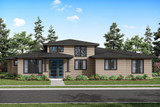What Makes Prairie Architecture Stand Out?
When one thinks of architectural styles that truly embody the spirit of their environment, prairie architecture often stands prominently. This architectural style, distinguished by its integration of form and function, harmonizes buildings with the natural landscape. But what continues to draw modern homeowners to this style?
Prairie homes are more popular than ever because of their timeless design and adaptability to modern needs. Originally conceived by the visionary architect Frank Lloyd Wright, the prairie style is characterized by its emphasis on horizontal lines that mimic the wide, flat expanses of America's midwestern plains. These homes are not just structures; they are complete environments designed to promote a sense of peace and integration with the surrounding landscape.
A defining feature of prairie architecture is its open floor plan, which encourages family interaction and a seamless flow between living spaces. Large windows are another hallmark, inviting ample natural light and offering expansive views of the outdoors. Together, these elements create a living space that is not only functional and spacious, but also deeply connected to its environment.
As we delve deeper into the historical roots and key features of prairie house plans in the following sections, we'll uncover why this style continues to resonate with homeowners looking for a home that combines beauty, practicality, and a profound respect for nature.
Historical Roots of Prairie House Plans
The prairie style, a distinct form of architecture that emerged in the late 19th and early 20th centuries, is deeply rooted in the ideas and philosophies of Frank Lloyd Wright and a small group of his contemporaries, often referred to as the Prairie School. Wright's vision was not just about building homes, but about creating a new, distinctly American style of living that was in harmony with the environment.
Central to prairie architecture are the low-pitched roofs and strong horizontal lines that echo the flat, expansive landscape of the American Midwest. These design elements not only define the aesthetic of prairie homes, but also represent a radical departure from the European styles that dominated American architecture at the time. Wright’s designs showcased an architectural democracy—spaces designed for the needs of the average American family, emphasizing comfort and utility over ornamentation.
The incorporation of large windows was another revolutionary aspect of prairie design. These windows did more than just bring in natural light; they served to erase the boundaries between inside and outside, extending the living space into the surrounding landscape. This design philosophy was reflective of Wright's belief in 'organic architecture,' a principle that buildings should exist in harmony and respect with humanity and its environment.
Moreover, the horizontal lines of Prairie homes were not merely aesthetic but functional, helping to stabilize the structure and distribute load more evenly. This architectural innovation was a response to the challenges of building on the expansive clay soils of the Midwest, which were prone to shifting and settling.
As we explore these historical roots, it becomes evident how the revolutionary features of prairie house plans—low-pitched roofs, horizontal lines, and large windows—have not only influenced modern architectural design, but have also cemented their appeal for homeowners seeking a style that combines beauty with practicality. These foundational elements continue to influence how prairie homes are designed today, allowing them to meet contemporary needs while staying true to their philosophical origins.
Key Features of Prairie Style Homes
Building on its rich historical roots, prairie architecture is celebrated for its distinct and functional features that resonate deeply with modern homeowners. Each element of the prairie home is thoughtfully designed to enhance both the aesthetic appeal and livability of the space, providing a sanctuary that is both inviting and in tune with the environment.
Open-Concept Layout
One of the most defining features of prairie homes is the open floor plan. This architectural choice reflects a move away from the compartmentalized rooms of traditional designs, favoring instead a layout that promotes airflow and social interaction. The living room, dining room, and kitchen merge into a cohesive living space that fosters family gatherings and effortless communication.
Strong Horizontal Lines
The emphasis on horizontal lines continues to be a signature of prairie design, extending beyond the exterior into the interior elements. These lines, visible in everything from the long rows of windows to the wide overhanging eaves, help to visually anchor the home to its site, promoting a sense of stability and tranquility.
Hipped Roofs
Hipped roofs are another hallmark of this style, featuring slopes on all sides that descend towards the walls. This design not only contributes to the visual harmony of the house, but also offers practical benefits like enhanced resistance to high winds, making it ideal for many American climates.
Integration with the Surrounding Landscape
Prairie homes are designed to be extensions of the natural landscape, with large windows and glass doors that frame views and invite the outdoors in. The use of natural materials like stone and wood in construction enhances this connection, helping the structure to blend seamlessly with its environment.
Exterior Materials
The choice of exterior materials in prairie homes further reflects Wright's organic architecture philosophy. Materials are often local to the area, sustainable, and chosen for their natural beauty and durability. The textures and colors of the materials typically complement the landscape, reinforcing the home’s integration with its surroundings.
These key features of prairie style homes do more than just define a visual style; they create a living experience. The thoughtful design elements ensure that the home is not just a place to live, but a space that enhances the quality of life of its inhabitants, promoting comfort, and connectivity to the natural world. As we move forward to explore how these timeless designs have adapted to modern needs, it becomes clear why prairie homes continue to capture the hearts of those looking to build or purchase a new home.
Modern Adaptations and Innovations
While prairie architecture has its roots firmly planted in the early 20th century, its evolution has not stagnated. Modern prairie homes have adapted to contemporary needs, incorporating new technologies and design philosophies that enhance both their functionality and environmental sustainability.
Adaptation to Modern Needs
Today’s prairie homes have embraced modern advancements in building technology and materials, allowing them to meet the higher standards of energy efficiency and sustainability that modern homeowners expect. For instance, the use of energy-efficient windows and insulation techniques has improved, ensuring that the large, picturesque windows of the prairie style do not lead to energy loss. Similarly, advancements in heating and cooling systems are compatible with the open floor plans of prairie houses, ensuring comfortable living environments year-round.
Sustainable Materials
Modern prairie designs continue to prioritize the use of natural materials, but with an increased focus on sustainability. Materials are often sourced locally to reduce environmental impact and are chosen for their durability and low maintenance. This not only supports local industries but also reduces the carbon footprint associated with transporting building materials.
Contemporary Functional Additions
Modern prairie homes often include features that cater to contemporary lifestyles, such as walk-in pantries, expansive master suites, and dedicated laundry rooms. These features add a level of convenience that aligns with today's expectations for functional home design. Additionally, technological integrations, such as smart home systems, are increasingly common, allowing homeowners to control lighting, climate, and security systems with ease.
Customization and Flexibility
The adaptability of prairie design to various lot sizes and landscapes is another reason for its enduring popularity. Today, architects and designers offer a range of customizable prairie house plans that allow homeowners to adjust layouts to suit their specific needs. From varying square footage to additional drawings for unique room additions, the options are extensive and flexible.
Aesthetic Innovations
Even with modern adaptations, the aesthetic principles of the prairie style remain intact. Designers continue to innovate within the framework of horizontal lines and open spaces, experimenting with new forms and scales that push the boundaries of traditional prairie design while maintaining its core principles.
These modern adaptations ensure that prairie architecture remains relevant and desirable, blending historical charm with contemporary efficiency and comfort. The ongoing evolution of this style demonstrates its ability to adapt to changing times while maintaining the integrity of its original vision. As we explore how to choose the right prairie house plan from a trusted provider like Associated Designs in the next section, it becomes clear that this architectural style offers both timeless beauty and modern practicality.
Choosing the Right Prairie House Plan with Associated Designs
When it comes to bringing the dream of owning a prairie-style home to life, selecting the right house plan is crucial. Associated Designs offers a wealth of options that cater to diverse needs and preferences, making it easier for prospective homeowners to find a plan that not only meets their requirements, but also embodies the timeless appeal of prairie architecture.
Understanding Your Needs
The first step in choosing the right prairie house plan is understanding your specific needs. Consider factors such as the size of your family, your lifestyle, and how much space you require. Associated Designs provides a variety of floor plans ranging from compact layouts ideal for smaller lots to more expansive designs suitable for larger properties. Each plan includes detailed descriptions of square footage, room dimensions, and additional features like open-concept layouts and large windows that define prairie style.
Exploring House Plan Features
When browsing through options, pay attention to key features that enhance living quality. For example, look for plans with open floor plans that promote a seamless flow between living, dining, and kitchen areas—a hallmark of prairie design. Features like walk-in pantries, large master suites, and ample storage spaces are also important considerations. Moreover, each plan is designed with the integration of indoor and outdoor spaces in mind, often featuring large porches or courtyard spaces.
Customization Options
One of the benefits of working with Associated Designs is the ability to customize any house plan to better fit your personal needs and site conditions. Whether it’s adjusting the orientation of the home to maximize natural light or modifying interior layouts to accommodate a home office, the team at Associated Designs can help tailor your chosen plan to meet your exact requirements.
Expert Guidance and Support
Finally, the experienced staff at Associated Designs are ready to assist you through the selection and customization process. They offer expert advice on architectural style, structural integrity, and design efficiency to ensure that your finished home is not only beautiful, but also functional and durable.
Choosing the right prairie house plan is more than just a practical decision—it's about creating a space that reflects your personal style and values, promoting a harmonious lifestyle in tune with your surroundings. With the right plan from Associated Designs, you can achieve a home that is both a sanctuary and a statement of timeless architectural beauty. Contact us today to get started!


